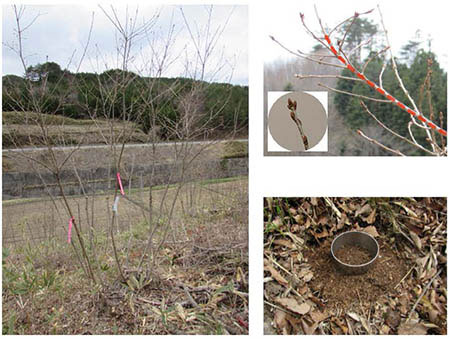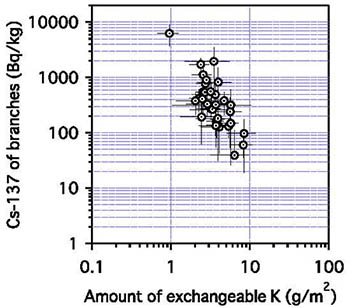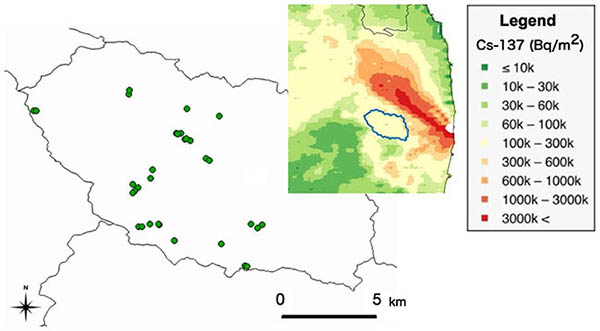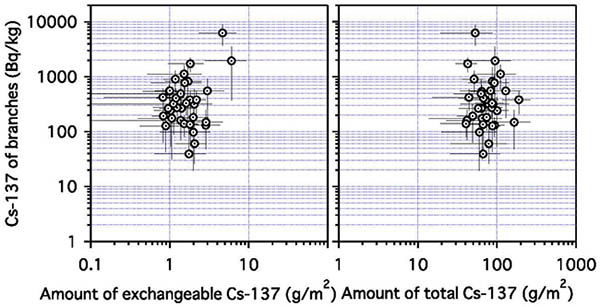Home > Research > Research Results > Research Results 2020 > Soil potassium determining radiocesium absorption in Konara oak - A new clue to determine available mushroom log forests
Update:December 7, 2020
Main content starts here.
Soil potassium determining radiocesium absorption in Konara oak
- A new clue to determine available mushroom log forests
| Article title |
Relationship between the activity concentration of 137Cs in the growing shoots of Quercus serrata and soil 137Cs, exchangeable cations, and pH in Fukushima, Japan |
|---|---|
| Author (affiliation) |
Tsutomu Kanasashi (a), Satoru Miura (b), Keizo Hirai (c), Junko Nagakura (c), Hiroki Itô (d) (a) Fukushima University, Fukushima, Japan. (b) Center for Forest Restoration and Radioecology, FFPRI, Tsukuba, Ibaraki, Japan. (c) Department of Forest Soils, FFPRI, Tsukuba, Ibaraki, Japan. (d) Hokkaido Research Center, FFPRI, Sapporo, Hokkaido, Japan. |
| Publication Journal |
Journal of Environmental Radioactivity, 220-221, September 20201 DOI:10.1016/j.jenvrad.2020.106276( External link ) |
| Content introduction |
Before the accident at the Fukushima Daiichi Nuclear Power Plant in March 2011, the Abukuma region in the Fukushima Prefecture was the main producer of logs for mushroom cultivation in Japan and the Fukushima Prefecture supplied a large number of logs to other prefectures. However, as a result of the accident, the mushroom log forest was contaminated with radioactive cesium. Early post-accident investigations indicated that, in order to cultivate mushrooms below the 100-Bq/kg standard for radioactive substances in food, logs with less than 50 Bq/kg were required. In the Abukuma region, as well as in the prefectures surrounding the Fukushima Prefecture, log production was halted after tests showed log radioactive cesium levels above 50 Bq/kg. Log mushroom producers are trying to resume the cultivation of log mushrooms by ordering logs from other prefectures, including from western Japan; however, there is a strong demand for the use of “local logs.” In this study, with the aiming to respond to such demands, we investigated the relationship between soil chemistry and radiocesium levels of Quercus serrata (Konara oak), a typical tree species used for logs. The survey was conducted in the winter of 2016–2017 in the town of Miyakoji, Tamura City, Fukushima Prefecture, a former major producer of mushroom logs (Fig. 1). We investigated the relationship between soil chemistry and cesium-137 in soil up to a depth of 5 cm, as well as the concentration of cesium-137 in branches of the current year (Fig. 2), in 34 Konara oak stands that were cut down and renewed after the nuclear accident. In addition to the exchangeable potassium in the soil, which is known to suppress the absorption of radioactive cesium, the exchangeable calcium and magnesium, and the pH of the soil were measured. The total amount of cesium-137 up to a depth of 5 cm and the amount of exchangeable cesium-137 were also measured. Cesium absorbed from the soil tends to accumulate in the growing parts of a tree. Therefore, the concentration of cesium-137 in the branches of the current year was used as an indicator of cesium-137 absorption and measurements were made in winter when the growth was stopped and the concentration of cesium-137 was stable. Significant effects on the concentration of cesium-137 in the branches of the current year were observed for the amount of exchangeable potassium and the amount of exchangeable cesium-137 in the soil (Figs. 3 and 4). In particular, the amount of exchangeable potassium in the soil had a significant effect on the concentration of cesium-137 in the Konara oak branches of the current year and the concentration of cesium-137 in the branches was lower when the amount of exchangeable potassium was higher (Fig. 3). For example, in two Konara oak forests, where the total amount of cesium-137 was 50–70 kBq/m2, the concentration of cesium-137 in the Konara oak branches was 6300 Bq/kg at a site with 1.0 g/m2 of exchangeable potassium, whereas it was 39 Bq/kg at a site with 6.4 g/m2 of exchangeable potassium, a ratio of approximately 1/160. In addition, the concentration of cesium-137 in Konara oak branches tended to be higher where the exchangeable cesium-137 content of the soil was high, indicating that the exchangeable cesium-137 content had a greater effect on the absorption of cesium-137 in Konara oak than the total cesium-137 content of the soil (Fig. 4).
Fig. 1. Locations of the 34 forests used for the mushroom log survey sites (green circles) and the distribution of cesium-137 deposition (inset). (Deposition data are as of June 28, 2012, from the Radiation Distribution Map expansion site/GIS Map of the Geospatial Information Authority of Japan and the Nuclear Regulatory Commission. The area in the center of the inset map shown with the blue line is Miyakoji, Tamura City, Fukushima Prefecture.).

Fig. 2. A regenerated Konara oak stump in a mushroom log forest (left), the branches of the current year (upper right), and soil samples collected from a depth of 0–5 cm near the stump (lower right) in the survey area. Five Konara oaks were surveyed in each study area. In the upper right photo, all branches except the thick branch of the previous year, shown by the red dashed line, are branches of the current year. These branches can be distinguished with winter buds (shown in the circular inset).

Fig. 3. Relationship between the cesium-137 concentration of Konara oaks and the exchangeable potassium in the soil up to a depth of 5 cm. Both graph axes are logarithmic and differ by tenfold. Higher soil exchangeable potassium levels are associated with lower concentrations of cesium-137 in the branches of the current year, resulting in a negative correlation.
Fig. 4. Relationship between the exchangeable (left) and total (right) cesium-137 of soil up to a depth of 5 cm and the concentration of cesium-137 in the Konara oak branches of the current year. The graph axes are logarithmic and differ by tenfold. For the cesium-137 concentration in the branches of the current year, the relationship with the exchangeable cesium-137 is clearer than that with the total cesium-137 in the soil. |
Copyright © Forest Research and Management Organization. All rights reserved.


